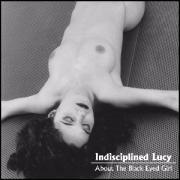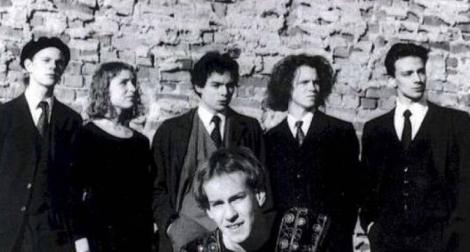 Sometimes it happens to listen to a record, after many years, of a band that went almost unnoticed at the time, with only one album under its belt, and to ask yourself some questions about the music, the stories told by the songs and the reason why the band disappeared soon after. And you think that all this is a shame because the music you’re listening to is interesting and quite original… although obviously not a masterpiece anyway. Then you think that we are in 2021 and that today's technological tools allow you to satisfy these and other questions ... Sometimes it happens to listen to a record, after many years, of a band that went almost unnoticed at the time, with only one album under its belt, and to ask yourself some questions about the music, the stories told by the songs and the reason why the band disappeared soon after. And you think that all this is a shame because the music you’re listening to is interesting and quite original… although obviously not a masterpiece anyway. Then you think that we are in 2021 and that today's technological tools allow you to satisfy these and other questions ...
The only album by Swedish band Indisciplined Lucy, "About the Black Eyed Girl", was released in 1999 by the ephemeral German label RectAngular, a division of the almost equally ephemeral Angular Records. The album, whose visual presentation relied on an artwork depicting a naked girl, at the time obtained some tepid appreciation but its memory was soon engulfed by the frenetic succession of record releases that soon make us forget many good releases, lost in a vast sea that leaves little behind. The music was an interesting combination of new Prog, new wave and chamber rock, rather particular, as we said.
We managed to get in touch with Pelle Lindroth, the band's guitarist and vocalist, via Facebook asking him to tell us a bit of the band's history, almost 25 years after the release of that beautiful album. Although obviously a little surprised by this request, he was kind and helpful enough to accept our proposal.
Can you tell us the story of Indisciplined Lucy? How did you start the band?
The band was started in Uppsala by me and two friends, Mikael Eriksson (guitar) and Jakob Luttinger (bass) around 1991 when we were still in junior high school. We called ourselves “Stairway to Hawaii” at first and pretty much learned to play our instruments along the way. We experimented with a few different drummers and eventually we found Elias Unge who was a few years older and went to the local music high school in Uppsala. He was more of a jazz drummer than our previous ones which we thought gave the music an interesting quality.
Soon after that we saw a gig with the band Brottpojken, and were very impressed with the stage appearance of frontman Gunnar Östman, who sang and played electric violin, so we asked him to join the band. The two missing pieces were added just soon after that, cello player Lisa Fagius and keyboardist Arvid Båve (later replaced by Arvid Nerdal for the album). Around that time we changed our name to Indisciplined Lucy. The name was a result of our lack of English skills, we meant it as an homage to the King Crimson album “Indiscipline” but didn't realize that there was no such word as “indisciplined”. Lucy was a character from a few of the songs we had written.
Was the inclusion of string instruments a precise choice or did it happen almost by chance?
When we brought on Gunnar a lot of the music got centered around his wild solo style with a lot of effects. But we also wanted to bring in some chamber music feel, so I started to write string arrangements for violin and cello. Lisa started playing the cello with us on demos and pretty soon became a permanent member of the band. I think the dynamics between the quieter string arrangements and the electric violin bursts is what really defines the music we wrote.
How did you define the music you played?What was your musical intent?
I'd say it was a mix of all sorts of things. On the one side we had our love for the albums of King Crimson, Yes, Hawkwind and others, but the songwriting was also heavily inspired by David Bowie, Cure and Bauhaus. For the string parts we listened to a lot of classical composers of the early 1900s like Stravinskij, but I'm not sure how much of that is detectable in the music.
We were kids and allowed ourselves to blend all our influences into something of our own. I think this gave us an advantage over other bands who were more concerned about staying with whatever genre they might be into and the boundaries that come with that.
How did you come to conceive your album?
We had recorded a lot of demos over the years and in 1996 we got a record deal with the Stockholm/Uppsala label Step One. They released a 4 track EP and then we recorded the album in a studio in Uppsala. Unfortunately, when the recordings were finished the label went out of business, which meant the recordings were locked in. Soon after that we moved to Stockholm and tried to get a bigger record company to release the album, but it didn't happen. So eventually we disbanded and everyone started doing stuff on their own, joining other bands and so on.
Four years later a German label (Angular) got in touch regarding the EP and when they heard we had an unreleased album they bought out the recordings and released it. We didn't have much to do with that process and really didn't get involved. We got a few copies but I don't think the album got distribution in Sweden. We haven't heard anything from Angular since the album was released.
 Can you explain the concept of the album and the story behind it? Who is Lucy? Can you explain the concept of the album and the story behind it? Who is Lucy?
I wanted the songs to connect with each other and being inspired by rock operas and song cycles like “Quadrophenia” and “Ziggy Stardust” I started to center the songs around the characters Lucy and the Clown. Lucy is kind of a Messiah figure who tries to break through in whatever ways possible and the Clown is both drawn to her and at the same time wants to destroy her. I wrote these songs in my teens and looking back on them I recognize these early feelings about sexuality, idealism and the struggle of becoming the person you want to be. The ending is rather bleak with Lucy being crushed by the weight of what she wants to achieve.
The CD artwork was very… peculiar. Why did you choose that kind of picture? Did you get any troubles for it?
We had a great album cover back when we first recorded the album, designed by our friend Frans Carlqvist. But as I recall it Angular didn't like that at all and thought it was too much “pop”. So they took their own photographs and designed the cover themselves. We didn't like it much, it was pretty sexist and harsh. But it was their decision in the end and I guess in a way it fits with the theatrical elements of the music and the lyrics.
Did you get a good feedback?
We did a few interviews with some European prog rock magazines but as I recall it we didn't get any feedback at all apart from a few reviews that I think were rather positive. Since the band had split up it didn't really matter much to us.
In hindsight, do you feel you could have done something differently, both on the album and in the life of the band?
Personally, I don't like my singing but I think the rest of the music stands up rather well. The production is a bit too clean maybe but it is what it is. I believe it was a great achievement by a gang of teenagers and it's kind of sad that we didn't get to release it when we were supposed to. If we had put the album out in 1996 I think we may have carried on for quite some time because we were doing really well and playing a lot of gigs. There were quite a few new songs that I would like to have recorded too.
What did the band members do after the breakup? Did you keep playing?
Some of us kept playing in other bands, and some pursued other careers. When we first moved to Stockholm we changed our name to Hynek and replaced the drums with producer Nya Sampan and his samplers. The music was a blend of our old style, pop and electronica. Later acts we have performed in include dance music collective Moder Jords Massiva, The Chrysler, Nya Sampan, Parken and in recent years Krake and King of Trees, which I think are the acts that mostly resembles Lucy. All of us have stayed connected to music one way or another and I think we're all pretty happy to have played together and created this music once upon a time.
Thank you very much for your time and for your kindness to reply to our questions!
Thank you for this trip down memory lane!

|